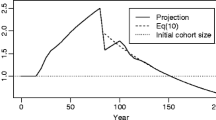Abstract
The aim of this study was to estimate the centenarian populations of Australia’s states from 1981 to 2012 and quantify the extent to which increases were driven by changes in births, survival and net migration. Centenarian numbers and cohort survival histories were estimated from death counts using the extinct cohort and survivor ratio methods. A decomposition method was applied to determine the relative contributions of births, cohort survival and net migration to population growth. Centenarian populations in all Australia’s states increased hugely over the three decades to 2012, driven mainly by improvements in survival from age 85 to 100. Survival improvement at younger ages also contributed to higher centenarian numbers, but not to the same extent as at the very high ages. The later arrival of the gold rush in Western Australia resulted in significant increases in births and decreases in net migration between the cohorts considered. Continued increases in births and survival improvement mean that centenarian numbers are likely to continue increasing rapidly in coming decades.



Similar content being viewed by others
References
Andreeva, M. (2012). About mortality data for Australia. Retrieved from Human Mortality Database. www.mortality.org. Accessed 11 Sept 2013.
Australian Bureau of Statistics (ABS). (2008). Australian Historical Population Statistics, 2008. Canberra.
Australian Institute of Health and Welfare (AIHW). (2000a). Australia’s Health 2000. Canberra.
Australian Institute of Health and Welfare (AIHW). (2000b). Disability and ageing: Australian population patterns and implications. Canberra.
Coale, A. J., & Caselli, G. (1990). Estimation of the number of persons at advanced ages from the number of deaths at each age in the given year and adjacent years. Genus, 46(1/2), 1–23.
Dépoid, F. (1973). La mortalité des grands vieillards. Population (French Edition), 28(4/5), 755–792.
Fries, J. (1980). Aging, natural death, and the compression of morbidity. New England Journal of Medicine, 303(3), 130–135.
Jdanov, D. A., Jasilionis, D., Soroko, E. L., Rau, R., & Vaupel, J. W. (2008). Beyond the Kannisto–Thatcher database on old age mortality: An assessment of data quality at advanced ages. MPIDR Working Paper WP 2008-013, March 2008.
Kannisto, V. (1994). Development of oldest-old mortality, 1950–1990: Evidence from 28 developed countries, monographs on population aging vol. 1. Odense: Odense University Press. http://www.demogr.mpg.de/Papers/Books/Monograph1/start.htm. Accessed 12 March 2013.
Kannisto, V., Lauritsen, J., Thatcher, A. R., & Vaupel, J. W. (1994). Reductions in mortality at advanced ages: Several decades of evidence from 27 countries. Population and Development Review, 20(4), 793–810.
Oeppen, J., & Vaupel, J. W. (2002). Broken limits to life expectancy. Science, 296, 1029–1031.
Rau, R., Soroko, E., Jasilionis, D., & Vaupel, J. W. (2008). Continued reductions in mortality at advanced ages. Population and Development Review, 34(4), 747–768.
Robine, J.-M., & Saito, Y. (2003). Survival beyond age 100: The case of Japan. Population and Development Review, 29, 208–228.
Robine, J.-M., & Saito, Y. (2009). The number of centenarians in Europe. European Papers on the New Welfare, The Counter-Ageing Society, 13, 47–62.
Rowland, D. T. (1979). Internal migration in Australia., Census monograph series Canberra: Australian Bureau of Statistics.
Terblanche, W., & Wilson, T. (2014a). Understanding the growth of Australia’s very elderly population, 1976 to 2012. Journal of Population Ageing, 7, 301–322.
Terblanche, W., & Wilson, T. (2014b). An evaluation of nearly-extinct cohort methods for estimating the very elderly populations of Australia and New Zealand. PLoS One, 10(4).
Terblanche, W., & Wilson, T. (2014c). Application of nearly-extinct estimation methods at sub-national level in Australia. Working paper. University of Queensland, Queensland Centre for Population Research.
Thatcher, A. R. (1999). The demography of centenarians in England and Wales. Population Trends, 96, 5–12.
Thatcher, A. R., Kannisto, V., & Andreev, K. F. (2002). The survivor ratio method for estimating numbers at high ages. Demographic Research, 6(1), 1–18.
Vaupel, J. W. (1997). The remarkable improvements in survival at older ages. Philosophical Transactions of the Royal Society of London, 352(1363), 1799–1804.
Vaupel, J. W., & Jeune, B. (1995). The emergence and proliferation of centenarians. In B. Jeune & J. W. Vaupel (Eds.), Exceptional longevity: From prehistory to the present. Odense monographs on population aging Vol. 2. Odense: Odense University Press. http://www.demogr.mpg.de/Papers/Books/Monograph2/start.htm. Accessed 29 Jan 2013.
Vincent, P. (1951). La mortalité des vieillards. Population, 6, 181–204.
West, B. A. (2010). A brief history of Australia. New York: Facts on File Inc, An imprint of Infobase Publishing.
Wilmoth, J. R., Andreev, K. F., Jdanov, D. A., Glei, D. A., Boe, C., Bubenheim, M., Philipov, D., Shkolnikov, V., & Vachon, P. (2007). Methods protocol for the Human Mortality Database. University of California, Berkeley, and Max Planck Institute for Demographic Research, Rostock. http://mortality.org [version 31/05/2007]. Accessed 13 Feb 2013.
Acknowledgments
This paper was completed while the author was a Ph.D. student at the University of Queensland. She gratefully acknowledges receipt of a UQ scholarship. The author is also grateful for helpful comments received from Tom Wilson.
Author information
Authors and Affiliations
Corresponding author
Rights and permissions
About this article
Cite this article
Terblanche, W. Explaining the substantial growth of centenarian populations in Australia’s states, 1981 to 2012. J Pop Research 32, 81–93 (2015). https://doi.org/10.1007/s12546-015-9143-y
Published:
Issue Date:
DOI: https://doi.org/10.1007/s12546-015-9143-y




